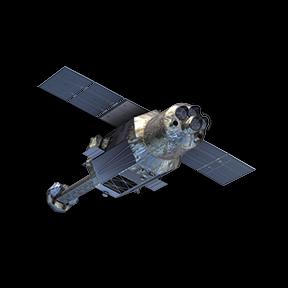|
|
Hitomi

The Hitomi (formerly Astro-H, known also as Next, New X-ray Telescope)
satellite was a Japanese astronomy mission working in the X-ray / Gamma ray energy range.
Though led by the Japan Aerospace Exploration Agency (ISAS/JAXA), it was an
international mission: major components and instruments were provided or
co-developed with NASA/GSFC, the European Space Agency (ESA), the Netherlands
Institute for Space Research (SRON), the Canadian Space Agency (CSA), and
Japanese, U.S., and European institutions.
Hitomi was equipped with four different instruments that together cover a wide energy
range 0.3-600 keV with imaging capability up to 80 keV and a gamma ray detector
for he high energy. An X-ray microcalorimeter providing a 7 eV non-dispersive
resolution was used in conjunction with an imaging telescope (0.3-12 keV).
Hitomi was launched by JAXA aboard a H-IIA rocket into low earth orbit on
February 17, 2016 from the Tanegashima Space Center in Japan. The mission was
in initial checkout when, on March 27, JAXA lost communications with the
satellite. On April 28, 2016, efforts to reconnect with the mission were
discontinued.
The Hitomi soft X-ray detectors (SXI and SXS) are duplicated in the
in the forthcoming
XRISM (formerly XARM) mission.
Mission Characteristics
 Lifetime : February 17–March 27, 2016
Lifetime : February 17–March 27, 2016
 Energy Range : 0.3–600 keV
Energy Range : 0.3–600 keV
 Special Features : “hyperspectral“ X-ray microcalorimeter
instrument, Imaging spectrometer above 10 keV.
Special Features : “hyperspectral“ X-ray microcalorimeter
instrument, Imaging spectrometer above 10 keV.
 Payload :
Payload :
- Soft X-ray Sectrometer (SXS). The unit consists of a Soft X-ray Telescope paired with a
a 6 pixel x 6 pixel X-ray Calorimeter Spectrometer (XCS). There are 35 active pixels in the main array,
with one inactive corner pixel. The XCS is enclosed in a Dewar cooling the detector at 50mK.
- Energy range : 0.3-12 keV
- Effective area : 210 cm2 at 6 keV; 160 cm2 at 1 keV
- Angular resolution : < 1.3 arcmin
- Field of View : 3 x 3 arcmin2
- Focal length : 5.6 meter
- Energy Resolution: < 7 eV at 6 keV
Additional components planned to use with the detector :
- A gate valve placed on top of the dewar intented to protect the detector during initial operation and to be removed in normal operation.
- A six filter wheel, mounted at 90 cm from the XCS, to use in normal operation norma. The six wheel positions
include two empty positions (i.e., no filter), a position with radioactive 55Fe calibration source, Be and neutral density (ND) filters
for X-ray attenuation, and a polyimide filter.
- A Modulation X-ray Source (MXS) mounted below the filter wheel. When turned on they illuminate the entire detector and use to calibrate
the energy scale. Consists of 4 leds operating in pair with targets composite of Cu/Cr and Al/Mg.
- Soft X-ray Imager (SXI). The unit consists of a Soft X-ray Telescope (identical to that for the SXS)
paired with 4 CCDs in 2 x 2 configuration. Each CCD is an array of 640 x 640 pixels
- Energy range : 0.4-12 keV
- Effective area : 360 cm2 at 6 keV
- Angular resolution : < 1.3 arcmin
- Field of View : 38 x 38 arcmin2
- Focal length : 5.6 meter
- Energy Resolution: < 200 eV at 6 keV
- Two Hard X-ray Imagers (HXI). Each unit consists of an Hard X-ray telescope (HXT)
paired with a Si/CsTe detector (four layers of Silicon and one layer of CsTe)
placed in a extandable optical bench (EOB).
- Energy range : 3-80 keV
- Effective area : 300 cm2 at 30 keV
- Angular resolution : 1.7 arcmin
- Field of View : 9 x 9 arcmin2
- Focal length : 12 meter
- Energy Resolution: 2 keV at 60 keV
The HXI system is supported by the Canadian ASTRO-H Metrology System (CAMS, one for each HXI unit) to provide real-time measurements of relative
displacement between the HXT optical axis and the detector placed in the EOB. Each CAMS unit consists of : (1) a laser and detector module
located on the top plate of the FOB (where the SXI and SXS detector are located), and (2) a passive target module mounted on the EOB detector plate.
- Two Soft Gamma-ray Detectors (SGD). Each unit consists of three identical
Compton Cameras (CC) each surrounded by active shields. Each CC uses a stack
of 32 layers of Si sensors and 8 layers of CdTe sensors
surrounded by 2 layers of CdTe sensors on each of the 4 sides.
- Energy range : 40-600 keV
- Effective area : > 20 cm2 at 100 keV in Compton Mode
- Field of View : 0.65 x 0.65 deg2
- Energy Resolution: < 4 keV at 60 keV
 Science Highlights:
Science Highlights:
Although the mission was lost very early in its intended lifespan, Hitomi
did collect some science useful science data.
- detailed insights into hot gas structure in the Perseus Cluster, revealing
an unexpected quiet environment with little turbulence at the heart of the
cluster.
 Archive: HEASARC hosts calibration data, a master catalog, trend, and observation data.
Archive: HEASARC hosts calibration data, a master catalog, trend, and observation data.
[Hitomi Home]
[Hitomi at DARTS (Japan)]
[All Missions]
[by Time]
[by Energy]
Page authors: Lorella Angelini Jesse Allen
HEASARC Home |
Observatories |
Archive |
Calibration |
Software |
Tools |
Students/Teachers/Public
Last modified: Thursday, 16-Oct-2025 15:53:28 EDT
|


